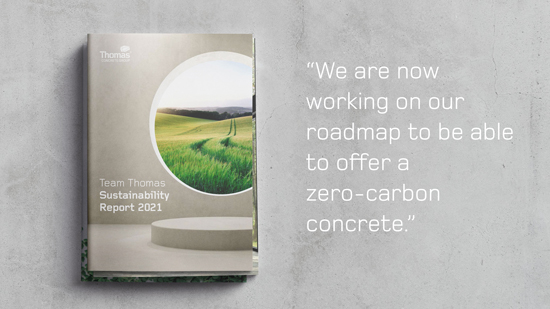Sustainability Report 2021 – Thomas Concrete Group
“We are now working on our roadmap to be able to offer a zero-carbon concrete.”
Gothenburg, Sweden, May 3rd, 2022
Thomas Concrete Group is presenting its 2021 Sustainability Report.
The report shows that in-depth research is underway to develop new, alternative binders, which will give concrete a lower carbon footprint. In addition, it can be read that the company will develop a plan in 2022 to be able to offer completely carbon-neutral concrete in the future.
Thomas Concrete Group has long been at the forefront of development in the industry, especially in terms of reducing the carbon footprint of concrete.

Prerequisite for the industry’s climate transition
In modern times, concrete binder has mostly constituted cement, which contributes to large CO2 emissions. In recent decades, however, it has become increasingly common to replace cement with alternative binders, such as coal fly ash or slag from the steel industry. The 2021 Sustainability Report shows that the company has come a long way with this through what it calls ‘low-carbon concrete’.
– “Concrete that today produces lower and, in the long term, no carbon dioxide emissions is a prerequisite for the industry’s climate transition,” says Karin Gäbel, Sustainability Manager at Thomas Concrete Group.
No magic solution
The sustainability report also shows that there is potential to achieve carbon neutrality when building with concrete.
– “However, there is no magic solution or quick fix,” says Ingemar Löfgren, Research and Development Manager at Thomas Concrete Group.
– “In our roadmap towards zero-carbon concrete, we have identified a number of focus areas that we are working intensively on today and will continue to pursue moving forwards.”
The right concrete in the right place
It involves optimizing the low-carbon concrete, using as little binder as possible, and getting more customers and decision-makers, such as architects, property developers, entrepreneurs, and municipalities, to understand the importance of building with low-carbon concrete. It will be equally important to use the right products in the right place and to optimize concrete construction.
– “We still see examples where oversized concrete is used, with too much cement as a binder, just because that’s how it’s always been done,” explains Karin Gäbel.
– “If we can get more customers and users to understand that concrete with alternative binders has a significantly lower climate impact, the entire construction industry can together contribute to the climate transition.”
Carbonatization and energy efficiency
In the operational phase of a building, when the concrete is cast and ready, it is important to be able to maximize the carbon dioxide uptake of the concrete, which is called carbonatization. At the same time, it is important to take advantage of the concrete’s thermal mass, which means that the temperature in a concrete building remains stable even when the outside temperature varies.
Reuse
Concrete is suitable for a circular economy owing to its long lifespan. Furthermore, crushed concrete can be reused as aggregate in new concrete, or, for example, it can be used in the base course in road construction. Thomas Concrete Group focuses on using residual concrete as a resource through reuse.
Thomas Concrete Group is driving the development of the concrete industry through research on new alternative binders to replace cement in the future and reduce climate impact. At the same time, intensive and targeted work is underway to deliver the first zero-carbon concrete before 2030.
>> Team Thomas Sustainability Report 2021 (PDF)
For more information, kindly contact:
Karin Gäbel, Sustainability Manager, Thomas Concrete Group AB
+46 (0)10 450 5201 | karin.gabel@thomasconcretegroup.com
About Thomas Concrete Group AB
Thomas Concrete Group is a Swedish family-owned group that produces and distributes high-quality concrete products and services. The company was established in 1955 in Karlstad, Sweden, by Martin Thomas, and today has operations in the USA, Poland, Germany, Norway and Sweden. The head office is in Gothenburg, Sweden. The Group has around 2,120 employees, produces 5.6 million m3 of concrete, and had a turnover of approximately SEK 7.8 billion in 2021. The subsidiary in the US is Thomas Concrete Inc. www.thomasconcretegroup.com





